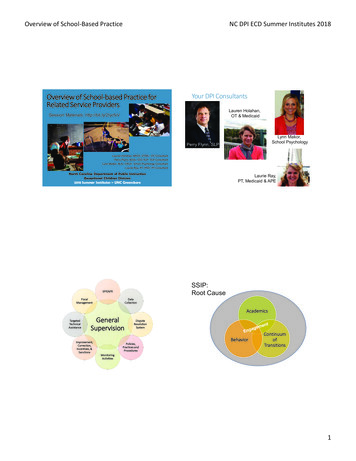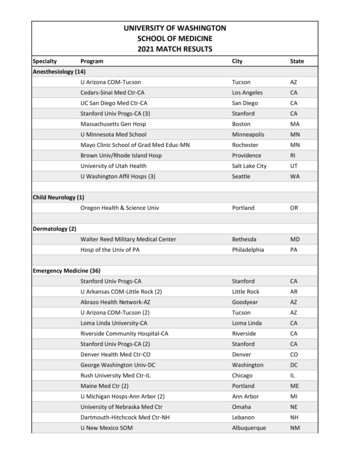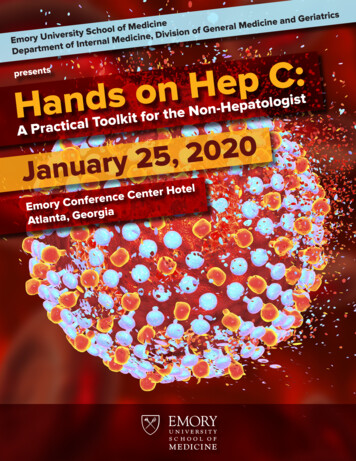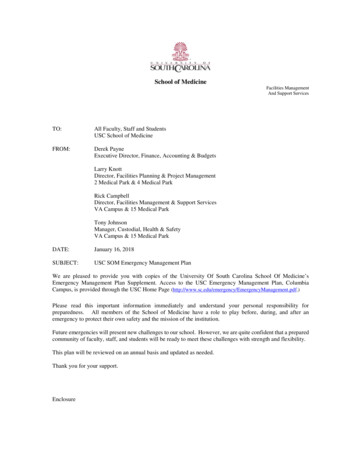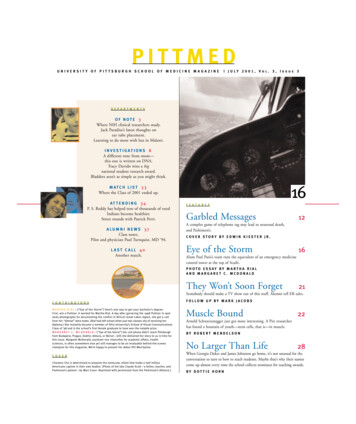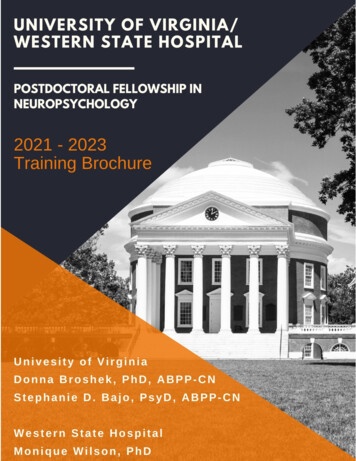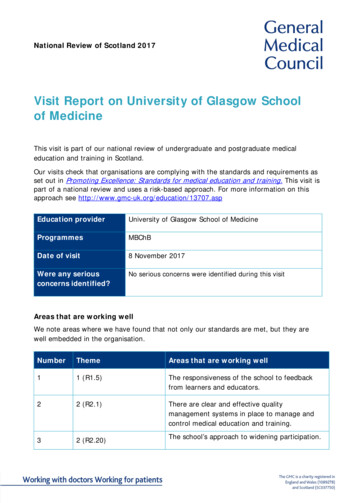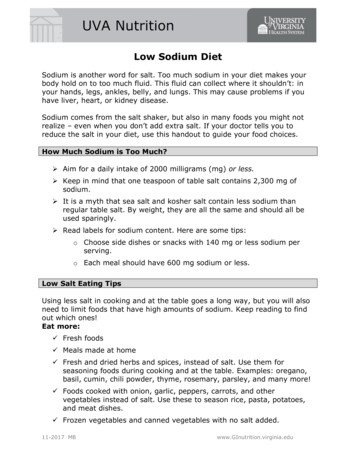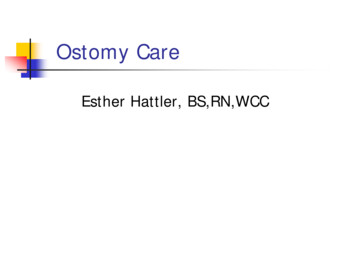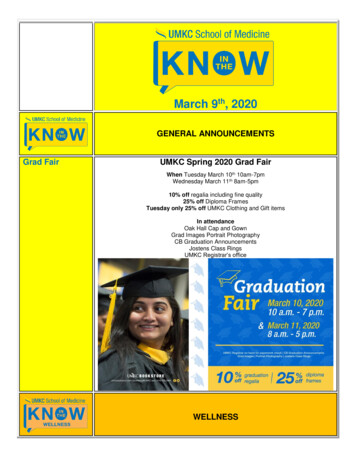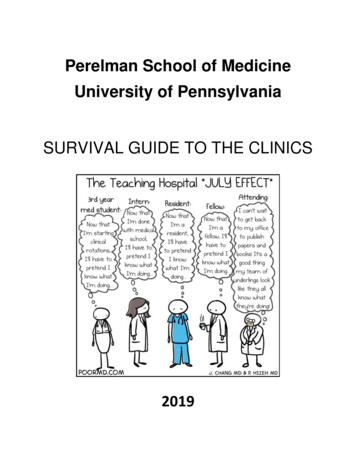
Transcription
Perelman School of MedicineUniversity of PennsylvaniaSURVIVAL GUIDE TO THE CLINICS2019
Introduction The transition from the basic sciences to the clinics is naturally intimidating. You’ll soon beimmersed in an unfamiliar environment that will demand greater responsibility andcommitment than anything you’ve previously encountered in medical school. But fear not!Taking care of patients is (hopefully) what you went to med school for in the first place. Overthe coming year, you will learn innumerable lessons in practical diagnosis and treatment,evidence review and effective communication, initiative and teamwork.While your clerkship year may often prove anxiety-provoking or exhausting, it will just as often hopefully more often - be exhilarating, exciting, and fun. You’ll interact daily and influentiallywith patients, become a valuable member of medical and surgical teams, see the practicalapplication of the things you’ve learned, and sense yourself beginning to develop into aclinician.This guide is intended to help ease your transition into the clinics. Each rotation and each sitehas its own distinct flavor. What you do as a student will vary from one rotation to the next andfrom team to team. Rather than attempt to describe every detail of each rotation, this SurvivalGuide presents general objectives, opportunities, and responsibilities, as well as some helpfuladvice from previous students. Above all, your fellow classmates and upperclassmen will be atremendous resource throughout this core clinical year.This booklet is formatted as a pocket reference to the clerkships. Part I contains generalinformation that may be helpful to review at the beginning of the year, and periodically as yougain more experience. Part II contains clerkship-specific information for reference before andduring each specific rotation. Part III contains a set of appendices with useful information oneverything from note templates to attendance policy to support resources.Enthusiasm, dedication, and flexibility are the keys to learning in the clinics. Throughout yourclinical experience, you’ll interact with an incredibly diverse group of attendings, residents, andstudents in a variety of medical environments. If you can adjust to these different situationsand maintain your enthusiasm, curiosity, integrity, and sense of purpose throughout, you willbe on the way to fun and fulfilling year, as well as the development of a strong clinical identity.We hope you find this guide helpful during your transition. You are not expected to knoweverything, only to learn a little more each day. Trust that your comfort, confidence, andabilities will increase with experience. Above all, don’t forget to relax and have fun. Good luckand have fun out there!1
Table of Contents INTRODUCTION 1 TABLE OF CONTENTS 2 ACKNOWLEDGEMENTS 4 PART I: GENERAL PRINCIPLES 5 THE TEAM 6{ The Physician Team }{ The Interdisciplinary Team }67 WORK 9{{{{{{{Rounds }Pre-Rounds }Work Rounds }Attending Rounds }Call }Filling Your White Coat }Topic Presentations }10101212141415 THE CHART AND CHARTING 16{{{{16171717The H&P }Progress Notes }Other Notes }Orders } ELECTRONIC MEDICAL RECORDS AND OTHER TECHNOLOGY 18{{{{18181920Getting to Know the EMRs }Other Electronic Systems }Accessing EMRs Remotely}Mobile Devices } STUDY AIDS FOR THE CLINICS 21 A NOTE ON WELLBEING 23 PART II: MODULE 4 CORE CLERKSHIPS 25 INTERNAL MEDICINE/FAMILY MEDICINE 25{ Internal Medicine }252
{ Family Medicine }32 PEDIATRICS/OBSTETRICS AND GYNECOLOGY 36{ Pediatrics }{ Obstetrics & Gynecology }3644 NEURO/PSYCH/EMERGENCY MEDICINE 50{ Neuro }{ Psychiatry }{ Emergency Medicine }505258 SURGERY/ ANESTHESIOLOGY/ THE “O”S 60{{{{{6068696969Surgery }Anesthesiology }Ophthalmology }Otorhinolaryngology }Orthopedics } PART IIII: APPENDICES 71 TEMPLATES 71{{{{71757576Detailed History and Physical }Progress Note }Sample Oral SOAP Presentation }Sample Patient Tracking Sheet } MEDICATION ORDERS 77 PHLEBOTOMY 77 EXPOSURE TO BLOOD AND BODILY FLUIDS 79 ATTENDANCE POLICY 81 TRANSPORTATION 82 SUPPORT RESOURCES 853
Acknowledgements This guide has been revised throughout the years and could not exist in its present formwithout the efforts of previous writers and editors, as well as the experience and advice ofprevious students. Special thanks goes to the Office of Student Affairs for helping to providethis information to students, to the Gold Humanism Honor Society for collaboration on previousversions, and to the current clerkship directors for fact-checking the rotation-specific material.Best of luck,AOA Class of 20194
Part I: General Principles Overall Advice General Approach Attitude: Having a good attitude and being a team player are as important for patient care asa strong fund of knowledge. Often they are more important. Respect: Respect your residents and attendings. (But do not kiss up; insincerity is obvious.) Humility: Learn how to say “I don’t know”—tough questions aren’t necessarily intended toevaluate you as much as they are expected to provide a starting point for teaching.Don’t beafraid to be wrong, either – people are usually interested in understanding how you thinkthrough a problem rather than just on whether you’ve memorized an answer. No one expectsyou to know everything. That’s why you’re here. Restraint: Do not show up or undermine a classmate or resident. Peer Teamwork: Consult your classmates. They are your greatest resource. Interdisciplinary Teamwork: Be friendly and collaborative with nurses, clerks, and otherstaff—they can teach you a great deal about your patients and about how things are done inthe hospital. Feedback: Ask for feedback at the end of every week from both attendings and residents tohelp you redirect your efforts if necessary and avoid surprises at the end of the rotation. Unfair Evaluations: Do not despair if you receive an unfair evaluation. Almost everyone getsat least one unexpected grade in the course of their clinical rotations.Organization/Workflow Timeliness: Always be prepared and on time for rounds. Organization: Get organized. Stay organized. Ask your interns, residents, upperclassmen, andclassmates for ideas on how they organize their patient information. Chart Familiarity: Take some time to learn your way around the different parts of the patientchart early on. Do the same with the computer systems. You can be a big asset to your team ifyou can perform an efficient “chart biopsy.” Initiative: As much as possible, try to anticipate the needs of your patients and your team. Beproactive. Don’t constantly repeat, “Is there anything I can do?” Pay attention on rounds – if it’smentioned that someone needs to obtain old records or perform a Mini-Mental Status Exam,volunteer!Developing Your Skills Thinking Through: Always brainstorm your own assessment and plan before asking yourresidents for theirs. You don’t have to be right, but thinking through your patients on your ownfirst is a valuable learning experience that is regarded highly.5
Thinking Ahead: Anticipate attendings’ and residents’ questions about abnormal lab values orother findings for your patients, and think about some possible explanations. You don’t need tobe right, but you need to show you noticed and are thinking. Literature: Don’t spend too much time on MedLine/OVID/Pubmed searching for the mostrecent articles. Concentrate on the basics, particularly through UpToDate. However, bringing ina relevant article once in a while related to a specific question the team had that week can behelpful. Questions: Don’t be afraid to ask for help. Don’t be afraid to ask questions. (However, betterquestions are ones that you couldn’t easily look up on your own.) Remember that no oneexpects you to know everything already; that’s why you are here. The Team { The Physician Team }A note on names: Interns and residents will definitely want you to call them by their first names,so feel free to do that from the start. Fellows will probably want you to call them by their firstnames too, but you could start with ”Dr.” if you feel nervous. With attendings, always use “Dr.”unless otherwise instructed.Intern: The intern, also known as a PGY-1 (post-graduate year 1), is in his/her first year as anMD/DO and has primary responsibility for the day-to-day needs of the patients. Beingoverworked and sleep-deprived, interns will often welcome any help provided by students;many interns will return the favor by talking you through how to accomplish routine tasks onthe floor. Expect to spend much of your time with the intern. They can be an incredible sourceof information in caring for patients and preparing presentations. While on some rotations theydo not directly evaluate medical students, on others they do, and residents and attendingsoften ask for their input at the end of the rotation.Resident: Residents are also known as PGY-2s, -3s etc. or sometimes JARs and SARs (Junior andSenior Admitting Resident). They ensure that the team runs smoothly, make routine patientcare decisions, and oversee the activities of the interns and medical students. Theirresponsibilities will vary depending on their level of training and specialty. Residents have hadmore years of experience, and they often have the most time and interest in teaching aboutvarious topics during your rotation. Teaching medical students is generally considered a corepart of the residents’ responsibilities. They are also the ones who will most often provide youwith direct instructions on which patients to follow, surgeries to attend, etc. The residentevaluation is a major component of the medical student grade.Chief Resident: Depending on the specialty, chief residents are either residents in their senioryear of residency (OB-GYN, Surgery) or residents spending an additional year before starting6
fellowship or becoming an attending (Internal Medicine, Pediatrics). Their roles vary fromspecialty to specialty, but usually they are involved in scheduling and overseeing all the juniorresidents in the program. In some cases, they may act as “Junior Attendings” and be theattending physicians on a service.Fellow: After having completed residency training in a general field, these individuals arepursuing specialty training as clinical fellows. For example, after completing five or seven yearsof training in general surgery, physicians may elect to spend three additional years of training asfellows in cardiothoracic surgery. The exact responsibilities of fellows depend on position andfield of interest. While your contact with fellows as a clerkship student will be limited, you willundoubtedly encounter them when you consult subspecialty services, in the clinics, and in theoperating room. If you are on a team with fellows, they are unlikely to evaluate you.House Staff: All physicians in training are collectively referred to as house staff or houseofficers.Attending: The attending physician has completed formal training. Attendings have titles suchas Assistant Professor, Associate Professor, and Professor, depending on level of experiencewithin the department. The attending is ultimately responsible for the care of patients on yourservice and accordingly will make all major decisions regarding patient management. He/sheruns attending rounds and is the person to whom you will present your patients. The attendingis often the person who asks you the most questions. While you should try to spend as muchtime with your attending as possible on the floor, in clinic, and in the OR, they are incrediblybusy and often will not make themselves available for you; the degree to which your attendingwill teach you is very individual- and discipline- dependent. The attending is usually responsiblefor writing your primary evaluation.Sub-Intern (Sub-I): A senior medical student who is taking an advanced course in which theytake on many of the responsibilities of an intern. Depending on the rotation, the Sub-I or Externwill either take the place of an intern or function in addition to existing interns.{ The Interdisciplinary Team }Allied health professionals are essential in the care of patients and can be extremely helpful tothe novice medical student. They deserve your utmost respect. Many of the senior nurses,therapists, and clerks have been around for generations of students and residents. They have awealth of knowledge to share, but they have also seen students make the same mistakes overand over again throughout the years; you may have to earn the benefit of the doubt withsome. If you are respectful and patient with colleagues (even when you or other members ofthe team feel frustrated), it will help produce better care for patients and a smoother, moresuccessful rotation for you.7
Nursing: Registered Nurses (RNs) wear Navy Blue scrubs, and Certified Nursing Assistants(CNAs) wear Maroon scrubs. Nurses are in charge of overseeing the routine, vital aspects ofpatient care. Among other things, they administer medications, administer other orders,monitor patient vital signs and activities, and provide supportive care. Some will insert IVs andperform routine phlebotomy. Charge nurses are nurses that supervise individual floors. Scrubnurses run operating rooms and maintain the sanctity of the sterile field. Nurse Practitionershave advanced degrees and are able to perform some of the duties of a physician. CNAs assistnurses in obtaining vitals and executing routine patient care activities. It is always a good ideato build a pleasant and cooperative relationship with the nurses.Physician Assistants: Physician Assistants (PAs) have bachelor’s degrees and then 2-3 years ofgraduate-level training, usually leading to a master’s degree. At HUP they work mostly on thesurgical services and may be part of the team of residents and med students, helping to do floorwork or seeing patients in clinic. They often act in similar roles to residents on these services,except they do not usually operate.Unit Clerk: Generally, clerks wear Khaki scrubs. They handle floor administrative business: theyanswer phones, schedule tests, complete paperwork, and generally keep things runningsmoothly. They typically sit at the nurse’s station and are an excellent source of practicalinformation (e.g., printing, transport, etc.). They may also help with obtaining outside hospitalrecords for your patients. A friendly relationship with unit clerks, in addition to making walkspast the nursing station more pleasant, can help you accomplish some of the logistical nittygritty crucial to the care of your patients.Patient Care Observers: Wear Brown scrubs. These staff, sometimes colloquially called “1-to1’s”, provide individual and continual observation for patients. They are not clinically trainedand provide no nursing care. They are ordered by the physician for patients who are a risk tothemselves (either overtly suicidal or, more commonly, delirious and pulling at lines and gettingout of bed). They will usually stay in the room when you interview the patient, but you can askthem to step out if you want to have a private conversation or exam. (If you do so, however,make sure you have thought through safety considerations for both yourself and the patient.)Physical Therapy: Physical Therapists (PTs) and Occupational Therapists (OTs) often wear blueGood Shepherd scrubs. Physical therapists evaluate and treat patients suffering from physicaldysfunction and pain resulting from illness. They emphasize motor rehabilitation training inorder to help patients regain joint mobility, strength, and coordination. (Think of them asdealing with gross or macro motor function.) They also evaluate patients’ level of functioningand make recommendations for what level of care or rehabilitation a patient will need whenhe/she is discharged. Their recommendations often play a major role in patients’ “disposition” the target endpoint of their hospitalization (back to home, to a rehabilitation facility, etc.).Occupational Therapy: OTs also deal with physical dysfunction, but their goal is to helppatients achieve independence in daily activities through exercise, fine motor skill repetition,8
and family education. (Think of them as dealing with micro motion.) They, too, can play a role indetermining patients’ destinations after hospitalization.Respiratory Therapy: Respiratory therapists (RTs) administer nebulizer treatments, performbedside pulmonary function tests (PFTs), and adjust ventilator settings in the Intensive CareUnits (ICUs).Social Work: Social workers act as liaisons between the patient and the patient’s careproviders, both within the hospital and out in the community. They assess the patient’s carenetwork outside the hospital, arrange for nursing home or chronic care placement as needed,and participate in family education and support. Coordination with them can often prove themost critical step in getting a patient safely discharged and having the interventions of ahospital stay translate into longer-term wellbeing.Clinical Resource Management: Clinical resource managers coordinate care for patients whowill be returning to their homes after discharge. They ensure that patients have neededequipment (such as CPAP machines, oxygen, and mobility equipment) when they leave thehospital for home. Again, their work is often the most important in ensuring that thestabilization or improvement achieved during hospitalization continues on the outside.Nutrition: A service staffed by both physicians and registered dietitians (RDs), nutrition staffaddress patient care issues such as intravenous nutrition, special diets, cachexia, etc.Chaplaincy: This service provides inpatients with worship services and spiritual counseling. Work While your responsibilities and opportunities in patient care will vary a great deal from monthto month depending on the clinical rotation and your team, the basic structure and generalprinciples that direct your activities are consistent throughout the clerkships.Your ability to get organized and stay organized will be very important in your future as astudent, a resident, and eventually as an attending physician. Regardless of your rotationschedule, you should test out and refine a personal system for recording and accessing patientinformation. Even though you will likely only be assigned 1-3 patients to follow closely andpresent on, having access to some information for all of the patients on your team will behelpful. This will allow you to follow along on rounds and write down any tasks that you canhelp out with later in the day. It will also demonstrate that you are interested in helping to carefor everyone on the team, not just your own patients.9
Most students and residents use printed copies of the day’s sign-out (a list of patients on theservice with a one-liner, test results, active medications, etc.), accessed from Carelign or EPIC,to take notes on pertinent information for the patients they are following as well as keep a listof to-dos. Ask your interns and residents how to print the sign-out, and try out the differentformats available to find which one you like best. Some carry a clipboard with a separate sheetfor each patient, while others manage with loose, jumbled scraps of paper. Some students evenopt to create their own sheets with pre-printed patient information templates. (Sample“scutsheets” that you might start with can be found on the “Downloads” page of the MedFoolswebsite, http://www.medfools.com/downloads.php, and in Part III below.){ Rounds }Regardless of the specialty, all of your inpatient rotations will entail rounds. Rounds providestructure for the interaction between the patient and the health care team, and amongmembers of the health care team itself. For some of your clinical rotations, you will beresponsible for individual patients whom you “pick up”. You will be
year of residency (OB-GYN, Surgery) or residents spending an additional year before starting . 7 fellowship or becoming an attending (Internal Medicine, Pediatrics). Their roles vary from specialty to specialty, but usu
